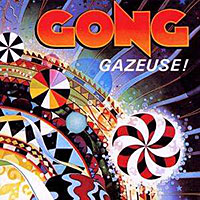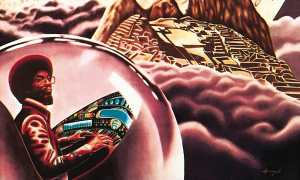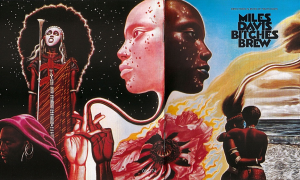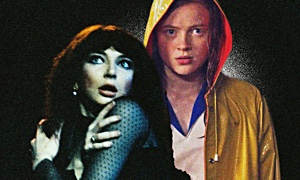Home » Jazz Articles » Rediscovery » Gong: Gazeuse!
Gong: Gazeuse!
 Gong
GongGazeuse!
Virgin
1976
Today's Rediscovery is Gazeuse! (released in North America as Expresso, by Canterbury-related band Gong, caught in a period of significant transition.
The group first came together under the leadership of Australian-born Daevid Allen, an early member of Soft Machine who, after being denied reentry into the UK due to visa problems in 1967, remained in France and formed Gong largely around a group of French musicians including saxophonist/flautist Didier Malherbe, the only original member left by the time Gazeuse! was released in 1976.
While not titled as such, Gazeuse! was really the first release by a Gong offspring, Pierre Moerlen's Gong, which largely abandoned the psychedelic space rock of such early Gong releases as the classic Radio Gnome Trilogy (also featuring guitarist Steve Hillage) for a more jazz-rock fusion sound. Its immediate predecessor, Shamal (Virgin)—released earlier the same year and the first to feature the trifecta of Moerlen, vibraphonist Benoit Moerlen and vibraphonist/percussionist Mireille Bauer—hinted at the future direction of this Gong offshoot (the departed Allen later reuniting his vision of Gong, one that was more in-line with its early, hippy-aesthetic days). Shamal, however, featured vocals and was more progressive-leaning, thanks to Malherbe and bassist Mike Howlett's writing, and Hillage's echo-drenched guitar (he would leave the band, along with life partner Miquette Giraudy, before the album's February 1976 release).
Gazeuse! also features Francis Moze. A tremendous fretless bassist with a positively massive tone compared to American fretless innovator Jaco Pastorius, Moze demonstrated a similarly lithe dexterity as his American cousin that allowed him to lay down an unshakable groove while, at the same time, engaging in a more interactive way with the rest of his band mates. The album also includes an early appearance by Mino Cinelu, who would go on to greater fame with American fusion super group Weather Report and, in the last decade of his life, Miles Davis.
But beyond being defined by the rich sound of multiple mallet instruments (Bauer and the two Moerlen brothers all playing vibraphone and, in the case of Pierre and Bauer, marimba as well), the recruit that truly redefined this briefest of Gong incarnations was Allan Holdsworth. After first turning heads with just two solos on trumpeter Ian Carr's Belladonna (Vertigo, 1972), the guitarist quickly established himself for a previously unheard-of harmonic conception and positively frightening technique. By the time of Gazeuse!, in fact, he was already making waves on both shores of the Atlantic, having helped to redefine another Canterbury-originated group, Soft Machine, on its seminal Bundles (Harvest, 1975), while American drummer/Miles Davis alum Tony Williams had also recruited him for his New Lifetime band and the first (and best) of two records, Believe It (Columbia, 1975).
Here, however, Gazeuse! succeeds on the confluence of a number factors: a mallet and percussion rich sound rarely, if ever, heard in the rock world at the time; extraordinary writing from Pierre Moerlen, Moze and, in particular, Holdsworth, with the metal-tinged "Night Illusion" and two-part "Shadows Of," featuring a rare acoustic guitar solo from Holdsworth. Holdsworth's electric tone was still evolving, but had reached an early zenith: rich and sustaining enough to facilitate his legato approach and personal use of his guitar's whammy bar and occasional injection of other effects like ring modulation, but still possessing that extra bit of grit and bite that would later be lost (and then regained). But his acoustic solo on "Shadows Of " proved that, while many guitarists were only capable of executing rapid-fire runs with a more forgiving overdriven tone, Holdsworth managed cleanly articulated, cascading light- speed phrases of absolute perfection without it. And Gazeuse is also a rarity in the guitarist's discography for his contributions on violin and, on the ethereal "Percolations Part One," pedal steel guitar.
Malherbe's tenor saxophone tone is visceral, his flute work on tunes like "Shadows Of" beautifully ethereal. And beyond a massive drum tone and the chops to use it, Pierre Moerlen's writing for three mallet instruments on the two-part percussion feature that ends side one of the original vinyl, "Percolations," is a master class that's just as compelling as Swiss percussionist Pierre Favre's Singing Drums (ECM, 1984), but in a more rock-heavy context. Bauer and Benoit Moerlen's vibraphone and marimba act as the album's accompaniment instruments and, while they are rarely featured as improvising soloists, it's their combined ethereal yet grounded array of colors that render Gazeuse! so unique in the annals of progressive rock/fusion.
There would be a sequel, Expresso II (Virgin, 1978)—also released under the same Gong moniker—before the drummer's leadership would be acknowledged in the group's renaming to Pierre Moerlen's Gong, but with Holdsworth a guest on just four of its six tracks (and not soloing on all of them), it was a band still in transition, with constant personnel shifts throughout the rest of its life. Moze's replacement, Hansford Rowe (who joined for Expresso II and was equally impressive), would be Moerlen's only constant companion until Pentanine, which the drummer recorded with a group of Russian musicians in 2002 but was held up for release until 2004, the year before he passed away at the too-young age of 52.
There were high points on all of Moerlen's subsequent Gong albums, but none of the recordings matched Gazeuse! for its big sound, diverse yet consistently superior writing and superlative playing, in particular Holdsworth, who at this time had reached what some believe to be a career high point. His own recordings a a leader—many of them true classics of a genre in which he stood head and shoulders above most—would further hone his compositional chops, harmonic language and instrumental facility, but without the ability to over-analyze his work and, sometimes, fix it so much that it would lose some of its edge, his work as a guest at times surpassed that of his own albums. Gazeuse! is one such record, commanding attention from the first moments of Moerlen's "Expresso" to the final, gentle notes of Moze's closing "Mireille."
[Note: You can read the genesis of this Rediscovery column here .]
< Previous
Top 12 "Most Recommended" Album Revie...
Next >
January 2015
Comments
About Gong
Instrument: Band / ensemble / orchestra
Related Articles | Concerts | Albums | Photos | Similar ToTags
Gong
Rediscovery
John Kelman
France
Paris
Daevid Allen
Jaco Pastorius
Mino Cinelu
Weather Report
Miles Davis
Allan Holdsworth
Soft Machine
Tony Williams
Pierre Favre
Hansford Rowe
For the Love of Jazz
 All About Jazz has been a pillar of jazz since 1995, championing it as an art form and, more importantly, supporting the musicians who create it. Our enduring commitment has made "AAJ" one of the most culturally important websites of its kind, read by hundreds of thousands of fans, musicians and industry figures every month.
All About Jazz has been a pillar of jazz since 1995, championing it as an art form and, more importantly, supporting the musicians who create it. Our enduring commitment has made "AAJ" one of the most culturally important websites of its kind, read by hundreds of thousands of fans, musicians and industry figures every month.
























